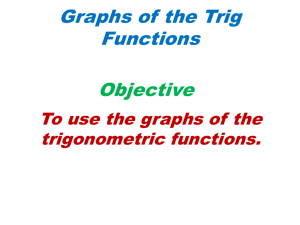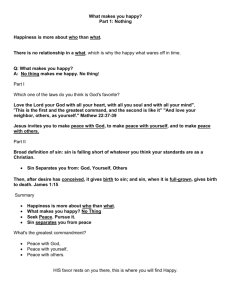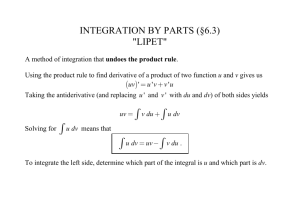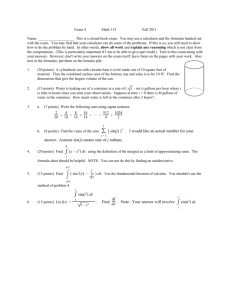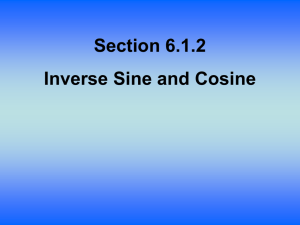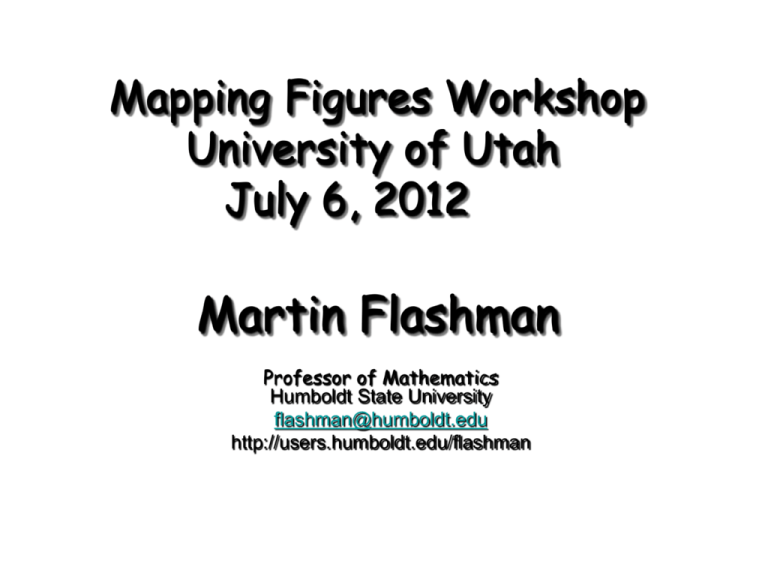
Mapping Figures Workshop
University of Utah
July 6, 2012
Martin Flashman
Professor of Mathematics
Humboldt State University
flashman@humboldt.edu
http://users.humboldt.edu/flashman
Session I Linear Mapping Figures
We begin our introduction to mapping
figures by a consideration of linear
functions :
“ y = f (x) = mx +b ”
Mapping Figures
A.k.a.
Function Diagrams
Dynagraphs
Written by Howard Swann and John Johnson
A early source for visualizing functions at an
elementary level before calculus.
This is copyrighted material!
Function Diagrams by Henri Picciotto
a
b
a
b
Mapping Diagrams and Functions
• SparkNotes › Math Study Guides › Algebra II:
Functions Traditional treatment.
– http://www.sparknotes.com/math/algebra2/functions/
• Function Diagrams. by Henri Picciotto
Excellent Resources!
– Henri Picciotto's Math Education Page
– Some rights reserved
• Flashman, Yanosko, Kim
https://www.math.duke.edu//education/prep02/te
ams/prep-12/
•
•
•
•
•
Outline of Remainder of
Morning…
Linear Functions: They are everywhere!
Tables
Graphs
Mapping Figures
Excel, Winplot and other technology
Examples
• Characteristics and Questions
• Understanding Linear Functions Visually.
Visualizing Linear Functions
• Linear functions are both necessary, and
understandable- even without considering their
graphs.
• There is a sensible way to visualize them using
“mapping figures.”
• Examples of important function features (like “slope”
and intercepts) will be illustrated with mapping
figures.
• Examples of activities for students that engage
understanding both function and linearity concepts.
• Examples of these mappings using simple straight edges as well
as technology such as Winplot (freeware from Peanut Software),
Geogebra, and possibly Mathematica and GSP
• Winplot is available from
http://math.exeter.edu/rparris/peanut/
Linear Functions:
They are everywhere!
• Where do you find Linear Functions?
– At home:
– On the road:
– At the store:
– In Sports/ Games
Linear Functions: Tables
x
3
2
1
5 x - 7
Complete the table.
x = 3,2,1,0,-1,-2,-3
f(x) = 5x – 7
0
-1
f(0) = ___?
-2
-3
For which x is f(x) > 0?
Linear Functions: Tables
xX
5 x – 7
f(x)=5x-7
3 3
88
2 2
33
1
-2
1
-2
0
-7
0
-7
-1
-12
-12
-2 -1
-17
-17
-3 -2
-22
-3
-22
Complete the table.
x = 3,2,1,0,-1,-2,-3
f(x) = 5x – 7
f(0) = ___?
For which x is f(x) > 0?
Linear Functions: On Graph
Plot Points (x , 5x - 7):
X
5 x – 7
3
8
2
3
1
-2
0
-7
-1
-12
-2
-17
-3
-22
Linear Functions: On Graph
Connect Points
(x , 5x - 7):
X
5 x – 7
3
8
2
3
1
-2
0
-7
-1
-12
-2
-17
-3
-22
Linear Functions: On Graph
Connect the Points
X
5 x – 7
3
8
2
3
1
-2
0
-7
-1
-12
-2
-17
-3
-22
Linear Functions: Mapping Figures
What happens before the graph.
• Connect point x to
point 5x – 7 on axes
X
5 x – 7
3
8
2
3
1
-2
0
-7
-1
-12
-2
-17
-3
-22
Linear Functions: Mapping Figures
What happens before the graph.
X
5 x – 7
3
8
2
3
1
-2
0
-7
-1
-12
-2
-17
-3
-22
8
7
6
5
4
3
2
1
0
-1
-2
-3
-4
-5
-6
-7
-8
-9
-10
-11
-12
-13
-14
-15
-16
-17
-18
-19
-20
-21
-22
Examples on Excel, Winplot,
Geogebra
• Excel example:
• Winplot examples:
–Linear Mapping examples
• Geogebra examples:
– dynagraphs.ggb
– Composition
Web links
• https://www.math.duke.edu//education/prep02/teams/pre
p-12/
• http://users.humboldt.edu/flashman/TFLINX.HTM
• http://www.dynamicgeometry.com/JavaSketchpad/Galler
y/Trigonometry_and_Analytic_Geometry/Dynagraphs.ht
ml
• http://demonstrations.wolfram.com/Dynagraphs/
• http://demonstrations.wolfram.com/ComposingFunctions
UsingDynagraphs/
Function-Equation Questions
with mapping figures
• Solving a linear equations: 2x+1 = 5
2x+1 = x + 2
– f(x) = 2x+1: For which x does f(x) = 5 ?
– g(x) = x+2: For which x does f(x) = g(x)?
• Find “fixed points” of f : f(x) = 2x+1
– For which x does f(x) = x?
Simple Examples are important!
• f(x) = x + C Added value: C
• f(x) = mx Scalar Multiple: m
Interpretations of m:
–
–
–
–
–
–
slope
rate
Magnification factor
m > 0 : Increasing function
m = 0 : Constant function [WS Example]
m < 0 : Decreasing function [WS Example]
Simple Examples are important!
f(x) = mx + b with a mapping figure -Five examples:
• Example 1: m =-2; b = 1: f(x) = -2x + 1
• Example 2: m = 2; b = 1: f(x) = 2x + 1
• Example 3: m = ½; b = 1: f(x) = ½ x + 1
• Example 4: m = 0; b = 1: f(x) = 0 x + 1
• Example 5: m = 1; b = 1: f(x) = x + 1
Visualizing f (x) = mx + b with a mapping
figure -- Five examples:
Example 1: m = -2; b = 1
f (x) = -2x + 1
Each arrow passes through a single
point, which is labeled F = [- 2,1].
The point F completely determines the
function f.
given a point / number, x, on the source
line,
there is a unique arrow passing through
F
meeting the target line at a unique point
/ number, -2x + 1,
which corresponds to the linear function’s
value for the point/number, x.
Visualizing f (x) = mx + b with a
mapping figure -- Five examples:
Example 2: m = 2; b = 1
f(x) = 2x + 1
Each arrow passes through a single
point, which is labeled
F = [2,1].
The point F completely determines
the function f.
given a point / number, x, on the source
line,
there is a unique arrow passing through
F
meeting the target line at a unique point
/ number, 2x + 1,
which corresponds to the linear function’s
value for the point/number, x.
Visualizing f (x) = mx + b with a
mapping figure -- Five examples:
Example 3: m = 1/2; b = 1
f(x) = ½ x + 1
Each arrow passes through a single
point, which is labeled F = [1/2,1].
The point F completely determines the
function f.
given a point / number, x, on the source
line,
there is a unique arrow passing through F
meeting the target line at a unique point /
number, ½ x + 1,
which corresponds to the linear function’s
value for the point/number, x.
Visualizing f (x) = mx + b with a mapping
figure -- Five examples:
Example 4: m = 0; b = 1
f(x) = 0 x + 1
Each arrow passes through a single
point, which is labeled F = [0,1].
The
point F completely determines the
function f.
given a point / number, x, on the source
line,
there is a unique arrow passing through F
meeting the target line at a unique point /
number, f(x)=1,
which corresponds to the linear function’s
value for the point/number, x.
Visualizing f (x) = mx + b with a
mapping figure -- Five examples:
Example 5: m = 1; b = 1
f (x) = x + 1
Unlike the previous examples, in this case it is not a single point that
determines the mapping figure, but the single arrow from 0 to 1,
which we designate as F[1,1]
It can also be shown that this single arrow completely determines the
function.Thus, given a point / number, x, on the source line, there is a
unique arrow passing through x parallel to F[1,1] meeting the target
line a unique point / number, x + 1, which corresponds to the linear
function’s value for the point/number, x.
The single arrow completely determines the function f.
given a point / number, x, on the source line,
there is a unique arrow through x parallel to F[1,1]
meeting the target line at a unique point / number, x + 1,
which corresponds to the linear function’s value for the point/number, x.
Function-Equation Questions
with linear focus points
• Solve a linear equations:
2x+1 = 5
2x+1 = -x + 2
– Use focus to find x.
• “fixed points” : f(x) = x
– Use focus to find x.
End of Session I
• Questions
• Break - food and thought
• Partner/group integration task
Morning Break: Think about These
Problems (in Groups 1-2; 3-4)
M.1 How would you use the Linear Focus to find the mapping figure for
the function inverse for a linear function when m≠0?
M.2 How does the choice of axis scales affect the position of the linear
function focus point and its use in solving equations?
M.3 Describe the visual features of the mapping figure for the quadratic
function f (x) = x2.
How does this generalize for even functions where f (-x) = f (x)?
M.4 Describe the visual features of the mapping figure for the cubic
function f (x) = x3.
How does this generalize for odd functions where f (-x) = -f (x)?
Session II More on Linear
Mapping Figures
We continue our introduction to mapping
figures by a consideration of the
composition of linear functions.
Compositions are keys!
An example of composition with mapping
figures of simpler (linear) functions.
– g(x) = 2x; h(u)=u+1
– f(x) = h(g(x)) = h(u)
where u =g(x) =2x
– f(x) = (2x) + 1 = 2 x + 1
f (0) = 1 slope = 2
2.0
1.0
0.0
-1.0
-2.0
-3.0
Compositions are keys!
Linear Functions can be understood and
visualized as compositions with mapping
figures of simpler linear functions.
– f(x) = 2 x + 1 = (2x) + 1 :
• g(x) = 2x; h(u)=u+1
• f (0) = 1 slope = 2
2.0
1.0
0.0
-1.0
-2.0
-3.0
Compositions are keys!
Linear Functions can be understood and
visualized as compositions with mapping
figures of simpler linear functions.
Example: f(x) = 2(x-1) + 3
g(x)=x-1 h(u)=2u; k(t)=t+3
• f(1)= 3 slope = 2
2.0
2.0
1.0
1.0
0.0
0.0
-1.0
-1.0
-2.0
-2.0
-3.0
-3.0
Inverses, Equations and Mapping
Figures
• Inverse: If f(x) = y then invf(y)=x.
• So to find invf(b) we need to find any
and all x that solve the equation f(x) =
b.
• How is this visualized on a mapping
figure?
• Find b on the target axis, then trace
back on any and all arrows that “hit”b.
Mapping Figures and Inverses
Inverse linear functions:
• Use transparency for mapping figures– Copy mapping figure of f to transparency.
– Flip the transparency to see mapping
figure of inverse function g.
(“before or after”)
invg(g(a)) = a; g(invg(b)) = b;
2.0
1.0
0.0
-1.0
-2.0
• Example i: g(x) = 2x; invg(x) = 1/2 x
• Example ii: h(x) = x + 1 ; invh(x) = x - 1
-3.0
Mapping Figures and Inverses
Inverse linear functions:
• socks and shoes with mapping figures
• g(x) = 2x; invf(x) = 1/2 x
• h(x) = x + 1 ; invh(x) = x - 1
2.0
1.0
0.0
• f(x) = 2 x + 1 = (2x) + 1
-1.0
– g(x) = 2x; h(u)=u+1
– inverse of f: invf(x)=invh(invg(x))=1/2(x-1)
-2.0
-3.0
Mapping Figures and Inverses
Inverse linear functions:
• “socks and shoes” with mapping figures
• f(x) = 2(x-1) + 3:
– g(x)=x-1 h(u)=2u; k(t)=t+3
– Inverse of f: 1/2(x-3) +1
2.0
2.0
1.0
1.0
0.0
0.0
-1.0
-1.0
-2.0
-2.0
-3.0
-3.0
End of Session II
• Questions
• Lunch Break - food and thought
• Partner/group integration task
Lunch Break: Think about These
Problems (in Groups 1-3; 4-5)
L.1 Describe the visual features of the mapping figure for the quadratic function f (x) = x2.
Domain? Range? Increasing/Decreasing? Max/Min? Concavity? “Infinity”?
L.2 Describe the visual features of the mapping figure for the quadratic function
f (x) = A(x-h)2 + k using composition with simple linear functions.
Domain? Range? Increasing/Decreasing? Max/Min? Concavity? “Infinity”?
L.3 Describe the visual features of a mapping figure for the square root function g(x) = x
and relate them to those of the quadratic f (x) = x2.
Domain? Range? Increasing/Decreasing? Max/Min? Concavity? “Infinity”?
L.4 Describe the visual features of the mapping figure for the reciprocal function
f (x) = 1/x.
Domain? Range? “Asymptotes” and “infinity”? Function Inverse?
L.5 Describe the visual features of the mapping figure for the linear fractional function
f (x) = A/(x-h) + k using composition with simple linear functions.
Domain? Range? “Asymptotes” and “infinity”? Function Inverse?
Session III More on Mapping
Figures: Quadratic, Exponential
and Logarithmic Functions
We continue our introduction to mapping
figures by a consideration of quadratic,
exponential and logarithmic functions.
Quadratic Functions
• Usually considered as a key example of the
power of analytic geometry- the merger of
algebra with geometry.
• The algebra of this study focuses on two
distinct representations of of these functions
which mapping figures can visualize
effectively to illuminate key features.
– f(x) = Ax2 + Bx + C
– f(x) = A (x-h)2 + k
Examples
• Use compositions to visualize
– f(x) = 2 (x-1)2 = 2x2 -4x + 2
– g(x) = 2 (x-1)2 + 3 = 2x2 -4x + 5
• Observe how even symmetry is
transformed.
• These examples illustrate how a mapping
figure visualization of composition with
linear functions can assist in understanding
other functions.
Quadratic Mapping Figures
f(x) = 2 (x-1)2
= 2x2 -4x + 2
x = 1.000
t = 1.000
t = 0.000
f(x) = x^2
u = 0.000
y = 0.000
u = 0.000
y = -2.000
Quadratic Mapping Figures
g(x) = 2 (x-1)2 + 3
= 2x2 -4x + 5
y = 3.000
u = 3.000
x = 1.000
t = 0.000
t = 1.000
u = 0.000
y = -2.000
f(x) = x^2
f(x) = x^2
Quadratic Equations and Mapping
Figures
• To solve f(x) = Ax2 + Bx + C = 0.
• Find 0 on the target axis, then trace
back on any and all arrows that “hit” 0.
• Notice how this connects to x = -B/(2A)
for symmetry and the issue of the
number of solutions.
Definition
• Algebra Definition
bL = N if and only if log b(N) = L
• Functions:
• f(x)= bx = y; invf(y) = log b(y)
=x
• log b = invf
Mapping figures for
exponential functions and
“inverse”
t
t
x
x
52
Visualize Applications with
Mapping Figures
“Simple” Applications
I invest $1000 @ 3% compounded
continuously. How long must I wait till
my investment has a value of $1500?
Solution: A(t) = 1000 e 0.03t.
Find t where A(t) = 1500.
Visualize this with a mapping figure
before further algebra.
f(x) = 1000*e^(0.03x)
1500
1000
“Simple” Applications
Solution: A(t) = 1000 e 0.03t.
Find t where A(t) = 1500.
Algebra: Find t where u=0.03t and 1.5 = eu
.
Consider simpler mapping figure on next
slide
1.5
1
“Simple” Applications
Solution: A(t) = 1000 e
0.03t.
Find t where A(t) = 1500.
Algebra: Find t where
u=0.03t and 1.5 = eu .
Consider simpler mapping
figure and solve with
logarithm:
u=0.03t = ln(1.5) and
t = ln(1.5)/0.03 13.52
1.5
1
Example: Using Mapping Figures
in “Proof” for Properties of Logs.
et+x = et ex = u*y where u = et and y= ex.
Thus by definition:
x = ln y ; t = ln u;
u*y
u=et
t+x
And t+x = ln(u*y) t
SO
x
ln u + ln y = ln(u*y)
y=ex
End of Session III
• Questions
• Break - food and thought
• Partner/group integration task
Session IV More on Mapping
Figures: Trigonometry and
Calculus Connections
We complete our introduction to mapping
figures by a consideration of
trigonometric functions and some
connections to calculus.
Seeing the functions on the unit circle with
mapping figure.
Sine and cosine of t measured on the vertical and
horizontal axes.
sin(t)
t
0
cos(t)
Note the visualization of periodicity.
Tangent Interpreted on Unit Circle
• Tan(t) measured on the axis tangent to the unit
circle.
(1,tan(t))
t
0
• Note the visualization of periodicity.
Even and odd on Mapping Figures
Even
Odd
f(a)
a
f(a) = f(-a)
a
0
0
-a
-a
0
-f(a) = f(-a)
Even Function Mapping Figures and
Graphs
00
-a-a
f(a)
f(a)==f(-a)
f(-a)
-a
-a
f(a)
aa
f(-a)= f(a)
An Even Function
An Even Function
0
0
a
a
Odd Function Mapping Figures and
Graphs
An Odd
Function
• Add
graphs
here.
f(a)
f(a)
a
-a
f(-a) = -f(a)
f(-a)= -f(a)
0
-a
0
a
66
Trigonometric functions and symmetry:
cos(-t) = cos(t) for all t. EVEN
sin(-t) = -sin(t) for all t. ODD
tan( -t) = - tan(t) for all t.
(a,b)
sin(t)
cos(t)
(a,-b)
Justifications from unit circle mapping figures
for sine, cosine and tangent..
Trig Equations and Mapping
Figures
• To solve trig(x) = z.
• Find z on the target axis, then trace
back on any and all arrows that “hit” z.
• Notice how this connects to periodic
behavior of the trig functions and the
issue of the number of solutions in an
interval.
• This also connects to understanding the
inverse trig functions.
Solving Simple Trig Equations:
Solve trig(t)=z from unit
circle mapping figures
for sine, cosine and
tangent.
Tan(t)=z
sin(t)=z
cos(t)
Winplot Examples for
Trig Functions
Trig Linear Compositions
Compositions with Trig
Functions
Example: y = f(x) =sin(x) + 3
sin( ---- )
(----) + 3
4
3
•
•
1
0
•
•
•
Mapping figure for
y =f(x) = sin(x) + 3
considered as a
composition:
First: u = sin(x)
Second: y =u+3 so
the result is
y = (sin(x)) + 3
Example: Graph of y = sin(x) +
3
y
x
Example: y = f(x) = 3 sin(x)
3*( ---- )
sin( ---- )
•
•
1
0
•
•
Mapping Figure for y = 3 sin(x) = 3 u where u = sin(x)
•
Mapping figure
for
y =f(x) = 3 sin(x)
considered as a
composition:
First: u = sin(x)
Second: y = 3u so
the result is
y = 3 (sin(x))
Example: Graph of y = 3 sin(x)
y
x
Interpretations
•
y= 3sin(x):
t -> (cos(t), sin(t))
-> (3cos(t),3sin(t))
unit circle magnified to circle of radius 3.
•
Y = sin(x) + 3:
t -> (cos(t), sin(t))
-> (cos(t), sin(t)+3)
unit circle shifted up to unit circle with center (0,3).
Show with winplot: circles_sines.wp2;
Scale change before trig.
Scale change before trig.
y
x
Scale change before trig
Altogether!
Mapping figure
2(----) + pi/3
sin( ---- )
3(----) + 2
5
5pi/6
2
1
0
-pi/6
-1
Graph
y
y = 3sin(2x+(pi/3)) + 2
x
Thanks
The End!
Questions?
flashman@humboldt.edu
http://www.humboldt.edu/~mef2
More References
More References
• Goldenberg, Paul, Philip Lewis, and
James O'Keefe. "Dynamic Representation
and the Development of a Process
Understanding of Function." In The
Concept of Function: Aspects of
Epistemology and Pedagogy, edited by Ed
Dubinsky and Guershon Harel, pp. 235–
60. MAA Notes no. 25. Washington, D.C.:
Mathematical Association of America,
1992.
More References
• http://www.geogebra.org/forum/viewtopic.php?f=
2&t=22592&sd=d&start=15
• “Dynagraphs}--helping students visualize
function dependency • GeoGebra User Forum
• "degenerated" dynagraph game ("x" and "y"
axes are superimposed) in GeoGebra:
http://www.uff.br/cdme/c1d/c1d-html/c1d-en.html
Thanks
The End! REALLY!
flashman@humboldt.edu
http://www.humboldt.edu/~mef2

